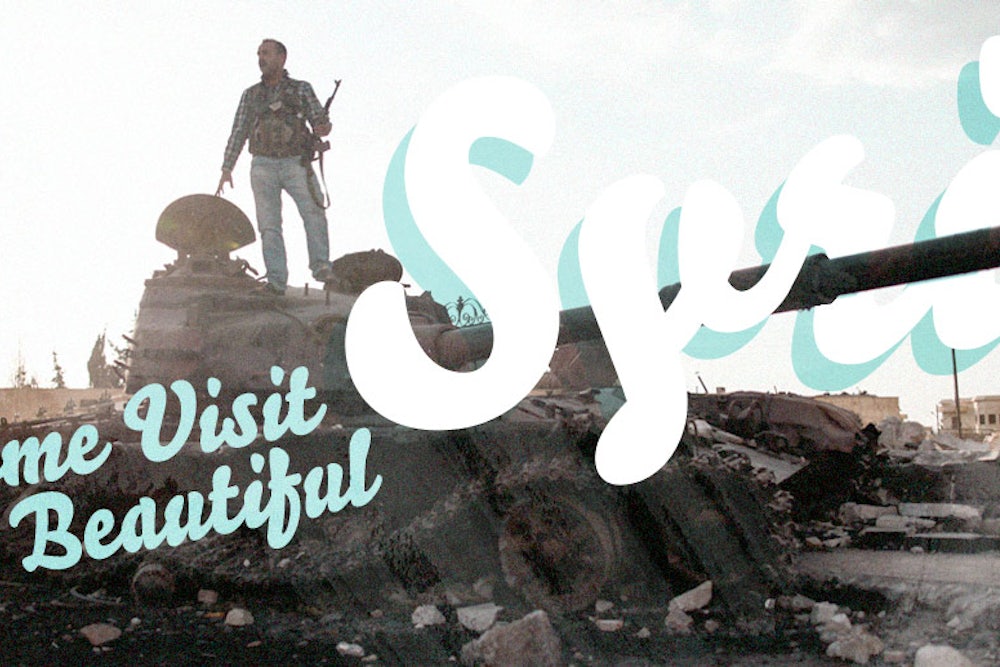More than any other leader, Bashar al-Assad needs to show the world that he’s here to stay. The rebels in Syria’s civil war say the crisis will not be resolved so long as he remains in power. Assad begs to disagree. His efforts to create an impression of a leader unconcerned about losing his job have included planning an election in the midst of the war (it takes place June 3, whether or not half the country remains displaced) and expressing dubious concern about public safety in Istanbul (following the demonstration in Gezi Park, Syria’s government advised citizens against visiting Turkey). This habit of feigning comfort is so entrenched that The Onion mocked it last year with a news story announcing that the regime was creating a “bike share” program in Damascus.
This year, though, Assad’s regime has one-upped the satirists: His government has decided to launch a new push for tourism.
In early May, the regime unveiled proposals to lure visitors to the Assad heartland of Lattakia, including a public beach equipped with a fast-food restaurant, a cafe that seats at least 200, and a parking lot for out-of-towners. Now may not be the best time for a trip to the beach in Lattakia: Rebel Islamist groups marched towards the province in late March. Although they lost in the end, their offensive alarmed the regime, which had to counter them by repositioning some of its forces from other areas.
Never mind. On May 11-12, the Ministry of Tourism held a forum highlighting small and medium-sized touristic projects at Damascus’s Dama Rosa Hotel. Twenty-four proposals, which the Ministry claims are ready for investment, came out of the forum, and some of them are located in Hama, a province where the regime’s future is tenuous. The Ministry granted a license for a 42-room hotel in Hama with a restaurant and health center containing a Jacuzzi, sauna, and steam room. How guests will be able to reach the facility safely is unclear: The hotel is located on the Homs-Hama road, which was bombed by the Free Syrian Army on April 16.
In a country where three UNESCO World Heritage Sites—Palmyra, Krac des Chevaliers and the Aleppo Citadel—have suffered damage while being used for military purposes, tourism may be a tough sell. But Assad has other reasons for it beyond just keeping up appearances.
For one thing, it’s an easy way to placate populations that are supportive of the regime, or simply accept its rule for the sake of stability: Plans are in place to renovate churches in Maaloula, a Christian-majority village north of Damascus and the only place in the world where Aramaic is still spoken. In mid-April, the regime retook Maaloula from Islamist rebels, following the destruction of several of its religious and historic sites. Since then, the regime has promoted religious pilgrimages to the village, branding the opposition as the destroyer and Assad as the rebuilder. The regime knows that a future Assad-led state, should one come to be, may be smaller than it once was. By promising tourism in the areas it knows it can control—Tartous and Suwayda have largely been spared from destruction—Assad’s government helps cement allegiances.
And in a country where capital flight, de-industrialization, and the pillaging of Syrian businesses has led GDP to contract by percentages that outstrip the decades-long Lebanese civil war, even far-fetched promises of rebuilding can resonate. The year before the Syrian uprising, tourism generated $8.3 billion and accounted for 12 percent of GDP, a 60 percent increase from 2009. As oil revenue declined, 4.6 million Arabs, 1.5 million Syrians living abroad, and 2.3 million other tourists provided the regime with a longer-term option for development and economic reform. In 2013, losses to the sector reached 330 billion Syrian pounds (around $2.2 billion). The number of visitors has declined by over 95 percent, 370 touristic establishments have closed down, and 11 percent of the population, which was previously employed in the sector, has been left jobless.
Thus when Bishar Yagizi, Syria's tourism minister, forecast a "prosperous tourist season" for the central province of Homs—the capital of which has been flattened and where some residents survived by eating grass and cats—the actual goal was almost certainly not to promote tourism in Homs. Instead, it was to remind Syrians of the stable country that was once ruled by an unchallenged regime.
Although Assad seems self-assured that some regions will come under his complete control, his confidence is overblown. The regime’s “Together, We Rebuild” campaign has left Damascenes skeptical. In early May, around 27 mortar and rocket attacks struck the capital and residents fear rebels will launch “D-Day” on election day next Tuesday. In Homs, site of that fabled "prosperous tourist season," Jabhat al-Nusra continues to carry out bombings that have left dozens dead. In Hama, the regime is encouraging tourism while it is allegedly using chemical weapons, especially chlorine gas (not included in the list of weapons that the regime has agreed to put under international control), to wear down the rebels.
There’s no word on whether the new tourist cafes will be equipped with gas masks.
